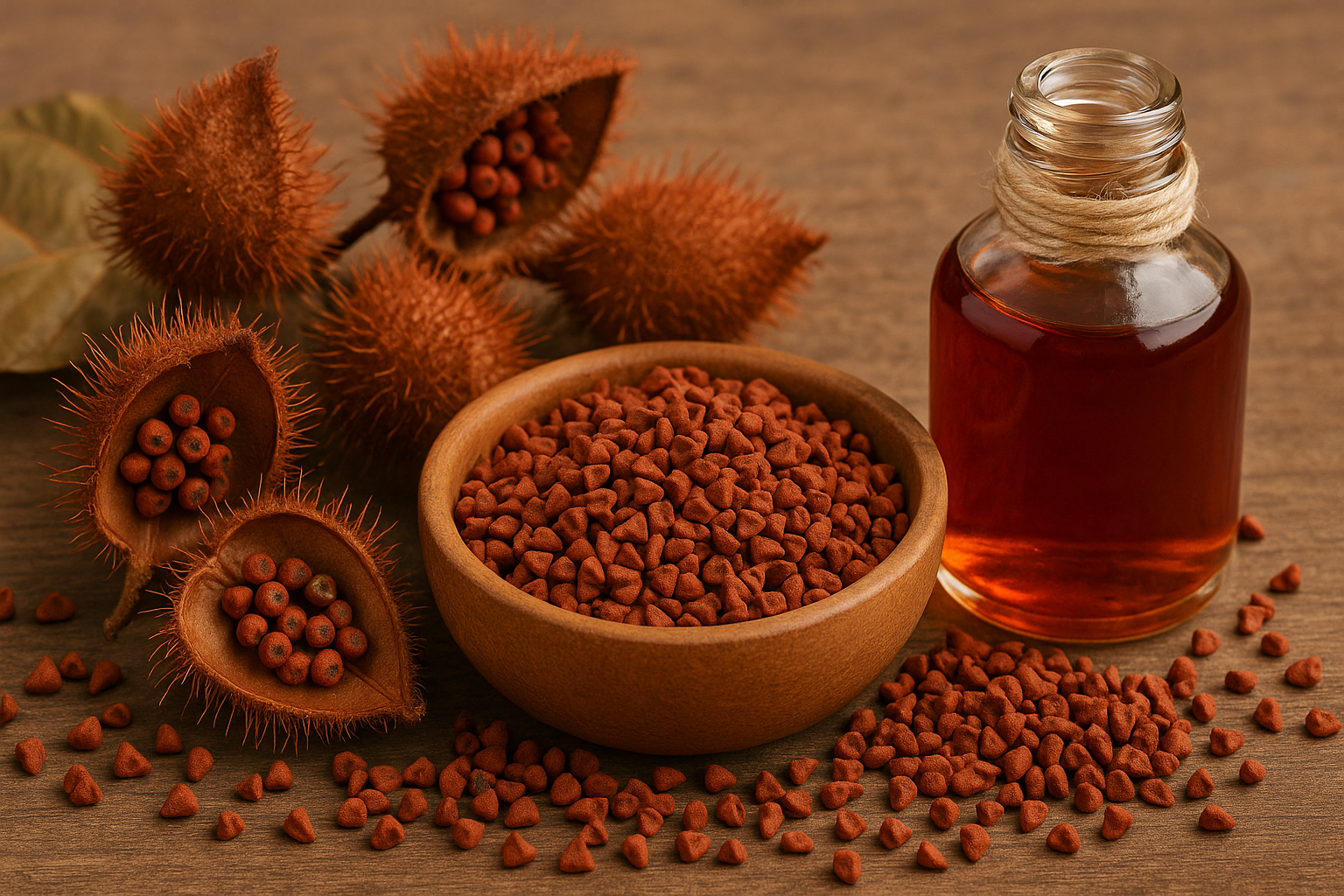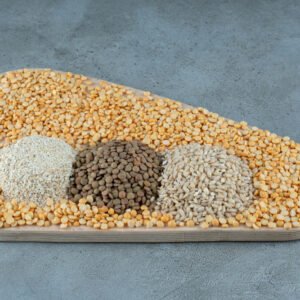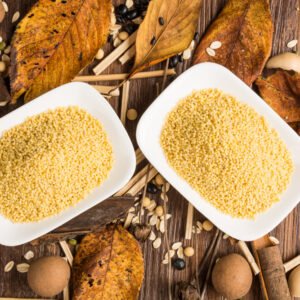Natural food coloring has revolutionized the food industry, and annatto stands as one of the most fascinating and versatile options available today. This vibrant, naturally-derived colorant has been transforming foods for centuries, offering both stunning visual appeal and remarkable benefits that synthetic alternatives simply cannot match.
Whether you’re a food manufacturer, culinary enthusiast, or simply curious about what creates those beautiful orange and yellow hues in your favorite foods, understanding annatto opens up a world of possibilities. Let’s break it down and explore everything this remarkable natural colorant has to offer.
What Is Annatto? Understanding This Natural Wonder
Annatto is a natural food coloring and flavoring derived from the seeds of the achiote tree (Bixa orellana), commonly used in cheese, butter, and snacks for its yellow to orange hue. This plant is native to Central and South America and represents one of the oldest known natural dye yielding plants.
The annatto seed contains powerful carotenoid pigments that create its distinctive coloring properties. The color of annatto comes from various carotenoid pigments, making it a completely natural alternative to synthetic food dyes.
Here’s what makes annatto unique:
- Derived from the seed coat of Bixa orellana fruits
- Contains natural carotenoids like bixin and norbixin
- Provides both coloring and flavoring properties
- Used for thousands of years by indigenous populations
- Safe and approved by major food safety organizations worldwide
The Science Behind Annatto Color Properties
Understanding how annatto creates its vibrant colors requires diving into its chemical composition. The secret lies in its carotenoid content, specifically two main compounds that determine its coloring strength and stability.
Primary Color Compounds
Bixin serves as the main coloring component in annatto seeds. This fat-soluble carotenoid produces the characteristic red-orange color that annatto is famous for. When processed differently, bixin can be converted to norbixin, which is water-soluble and creates more yellow tones.
The concentration of these compounds directly affects the intensity and shade of color produced. Higher bixin content results in deeper orange and red hues, while higher norbixin content produces brighter yellow shades.
Color Range and Variations
Annatto is often used to impart a yellow or orange color to foods, but the exact shade depends on several factors:
- Processing method used during extraction
- Concentration of the annatto extract
- pH levels of the food product
- Temperature during application
- Interaction with other ingredients
The natural color spectrum of annatto ranges from pale yellow to deep orange-red, making it incredibly versatile for various food applications.
Annatto Uses in Food Industry Applications
Annatto exhibits a high potential for use in a wide range of food commodities such as dairy products, flour confectionery, fish, soft drinks, meat products, snack foods, and dry mixes. This versatility has made it a staple ingredient across multiple food categories.
Dairy Products and Cheese Manufacturing
The dairy industry represents one of the largest consumers of annatto coloring. Cheese manufacturers use annatto to create the characteristic golden color in cheddar, colby, and other popular cheese varieties. The natural coloring enhances visual appeal while maintaining the authentic taste consumers expect.
Butter and margarine producers also rely heavily on annatto to achieve consistent color year-round, compensating for natural variations in milk fat color based on seasonal changes in cow diets.
Baked Goods and Confectionery
Annatto and its extracts are now used in many processed food products, such as custards, cakes and other baked goods. The heat stability of annatto makes it particularly valuable in baking applications where other natural colors might degrade.
Confectionery manufacturers appreciate annatto’s ability to create vibrant colors without affecting taste profiles, making it ideal for candies, chocolates, and other sweet treats.
Meat and Seafood Processing
Annatto is widely used in smoked fish, sausages, and other meat products. The natural preservation properties of annatto compounds provide additional benefits beyond coloring, helping maintain product quality and extending shelf life.
Health Benefits and Safety Profile of Annatto
Annatto is a natural food additive that has been linked to various benefits, including reduced inflammation, improved eye and heart health, and antioxidant, antimicrobial, and anticancer properties. These health benefits stem from the same carotenoid compounds that provide its coloring properties.
Antioxidant Properties
The carotenoids in annatto act as powerful antioxidants, helping protect cells from oxidative stress and free radical damage. These compounds support overall health while providing the desired coloring effects in food products.
Eye Health Support
Like other carotenoids, annatto compounds support eye health by filtering harmful blue light and supporting retinal function. Regular consumption of annatto-colored foods may contribute to long-term vision health.
Safety Considerations
Human studies on annatto’s benefits and side effects are lacking, and more research is needed. However, annatto has been used safely for centuries and is approved by major food safety agencies worldwide. Most people tolerate annatto well, though some individuals may experience allergic reactions.
Natural vs Synthetic Food Coloring: Why Annatto Wins
The shift toward natural food coloring has accelerated significantly in recent years, driven by consumer demand for cleaner labels and healthier ingredients. Annatto offers compelling advantages over synthetic alternatives.
Clean Label Benefits
Natural annatto provides the vibrant colors manufacturers need while meeting clean label requirements. Unlike synthetic dyes, annatto appears on ingredient labels as a recognizable, natural component that consumers understand and trust.
Stability and Performance
Modern annatto extracts offer excellent stability across a wide range of pH levels, temperatures, and storage conditions. This performance rivals synthetic alternatives while providing the natural origin consumers prefer.
Regulatory Advantages
Natural colorants like annatto face fewer regulatory restrictions compared to synthetic dyes. This regulatory environment provides manufacturers with greater flexibility and reduces compliance complexity.
Processing Methods and Extract Types
Different processing methods create various types of annatto extracts, each with specific properties and applications. Understanding these variations helps manufacturers select the right product for their needs.
Oil-Soluble Extracts
Oil-soluble annatto extracts like EXBERRY® Annatto OS Intense deliver powerful orange shades in fat-based applications including powdered cheese sauces, snack seasonings, and baked goods. These extracts work best in products with higher fat content.
Water-Soluble Extracts
Water-soluble annatto extracts, typically containing higher norbixin levels, work well in beverages, dairy products, and other water-based applications. These extracts provide excellent dispersion and color uniformity.
Powder Forms
Annatto powder offers convenience for dry mix applications and provides excellent shelf stability. This form works particularly well in seasoning blends, snack coatings, and baking mixes.
How CMS Industries Supports Natural Color Innovation
As a leading agricultural products manufacturer and exporter based in India, CMS Industries understands the growing demand for natural food ingredients like annatto. With over two decades of experience in sourcing and supplying premium agricultural products, CMS Industries connects food manufacturers with high-quality natural ingredients that meet international standards.
The company’s commitment to sustainable sourcing and ethical practices aligns perfectly with the values that drive the natural food coloring market. Through their extensive network and expertise in spices, herbs, and agricultural products, CMS Industries helps businesses access reliable supplies of natural coloring ingredients and other agricultural commodities needed for food production.
Their focus on quality, competitive pricing, and timely delivery makes them an ideal partner for companies looking to transition to natural ingredients or expand their natural product lines.
Future Trends in Annatto Applications
Efforts have been made in recent years to introduce annatto color in other non-food sectors such as dyeing. This expansion beyond food applications represents exciting opportunities for annatto utilization.
Cosmetic and Personal Care
The cosmetic industry increasingly values natural ingredients, and annatto’s coloring properties combined with its antioxidant benefits make it attractive for makeup, skincare, and personal care products.
Textile and Fabric Dyeing
Traditional textile applications of annatto are experiencing renewed interest as manufacturers seek sustainable and environmentally-friendly dyeing alternatives.
Pharmaceutical Applications
The pharmaceutical industry explores annatto for both coloring and potential therapeutic applications, leveraging its natural origin and bioactive compounds.
Taking Your Next Steps with Natural Food Coloring
The world of natural food coloring offers tremendous opportunities for manufacturers, food service operators, and consumers seeking healthier alternatives. Annatto represents just one example of how natural ingredients can deliver both performance and clean label benefits.
Whether you’re developing new products, reformulating existing ones, or simply seeking reliable sources for natural ingredients, partnering with experienced agricultural suppliers like CMS Industries can provide the expertise and supply chain support needed for success. Their commitment to quality agricultural products and international export capabilities make them an ideal resource for businesses ready to embrace natural food ingredients.
Ready to explore how natural colorants like annatto can transform your products? Connect with agricultural experts who understand both the technical requirements and market demands for natural food ingredients, and discover the possibilities that await in the world of natural food coloring.
Frequently Asked Questions About Annatto
What foods commonly contain annatto as a natural colorant?
Annatto appears in many everyday foods including cheddar cheese, butter, margarine, breakfast cereals, snack foods, baked goods, and processed meats. You’ll often see it listed as “annatto” or “annatto extract” on ingredient labels.
Is annatto safe for people with food allergies?
While annatto is generally safe for most people, some individuals may experience allergic reactions. People with known sensitivities to food additives should consult healthcare providers before consuming annatto-containing products regularly.
How does annatto compare to turmeric for natural yellow coloring?
Both provide natural yellow coloring, but annatto offers better heat stability and less flavor impact compared to turmeric. Annatto also provides orange and red shades that turmeric cannot achieve naturally.
Can annatto be used in organic food products?
Yes, annatto extracts that meet organic certification standards can be used in organic food products. The organic status depends on the extraction methods and processing techniques used.
What’s the shelf life of annatto-colored foods compared to synthetically colored ones?
Annatto-colored foods typically have comparable or better shelf life than synthetically colored products, especially when proper storage conditions are maintained. The natural antioxidant properties may actually help preserve product quality.





